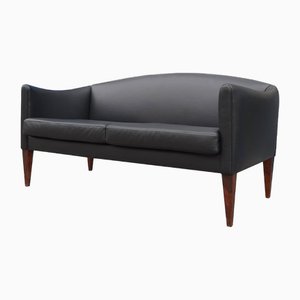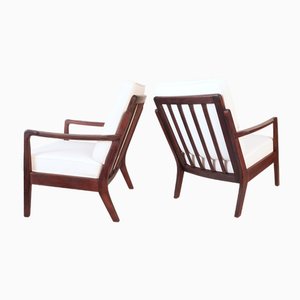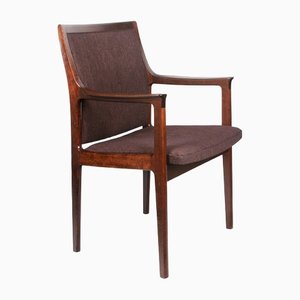Traduction générée automatiquement
Montrer le texte original
Montrer le texte traduit
Antonino Franchina was born in 1912 in Palmanova, Friuli Venezia Giulia, in the North East of Italy, but his parents were from Sicily and the family moved back to Palermo soon after his birth.
Nino grew up in Sicily and stayed there till 1934, when, after graduating in Sculpture at the Accademia di Belle Arti, he moved to Milan together with Renato Guttuso, Giovanni Barbera e Lia Pasqualino Noto. The four constituted the ‘Gruppo dei Quattro’ and exhibited at the Galleria del Milione in Milan in 1934, and then in Rome, in 1935 and 1937, respectively at the Galleria Bragaglia Fuori Commercio and at the Galleria della Cometa. For the first of these two shows, a catalogue featuring a presentation by Carlo Carrà, was published.
Along with Guttuso, Franchina joined the ‘Corrente’ group in Milan, before moving to Rome in 1938, where he met and married Gina Severini, daughter of the futurist artist Gino. Nino’s works were showed at the third Quadriennale (1939) and in a personal show at the Galleria Minima in 1943.
Franchina’s style was clearly figurative up until this point; after the war he started moving towards abstraction through a sort of expressionist period, in which a recurring subject was that of people in pain suffering from the war, often depicted using red ink. After the Italian liberation he took part to the exhibition ‘L'arte contro la barbarie’ at the Galleria del Secolo in Rome.
Well aware of the European sculpture developments, Franchina’s works became completely abstract between 1948 and 1950, when living in Paris he saw and studied the works by Picasso, Gabo, Calder and Brâncuși - he remained strongly connected to Sicily, to the Greek sculptures of Metope and Telamoni, but he admitted to be heavily influenced by Moore, Lipchitz, Laurens and Zadkine.
In 1948 Franchina was invited for the first time at the XXIV Venice Biennale, where he returned in 1950, 1952, 1954, 1958, 1966, 1968, 1972, 1978 and 1988.
In 1949 he had a personal show at the Galleria Pierre in Paris. In 1953 Franchina took part to the II Biennale of sculpture in Antwerp and to the exhibition about abstract art in Italy and France at the Galleria nazionale d'arte moderna di Roma. In 1958 he participated to the second edition of Documenta 2 Skulptur in Kassel, then he had shows in São Paulo, Pittsburgh, Munich and Tokyo in 1961.
In 1961 Franchina executed a bust of Antonio Gramsci, the work was commissioned from the Italian government for its collection of Italian Modern art. In 1965 he worked at the scenography of the ballet ‘Le Testament di François Villon’ with music by Ezra Pound e choreography by John Butler, which was part of the Spoleto Festival dei Due Mondi programme.
In 1975 anthological exhibition of his works was organised in Gubbio, within the VII Biennale d'arte del metallo.
The personal show at the Galleria Mara Coccia in Rome dates to 1986; in the same year he took part to the XI Rome Quadriennale.
After the artist’s death in 1987, his workshop in Via Margutta in Rome became the Severini-Franchina archive; it conserves documents, original photographs and objects that belonged to Nino Franchina and Gino Severini.
In 2011 a contemporary art museum in Sant'Agata Militello was opened and named after the sculptor.
Antonino Franchina est né en 1912 à Palmanova, dans le Frioul-Vénétie Julienne, au nord-est de l'Italie, mais ses parents étaient originaires de Sicile et la famille est retournée à Palerme peu après sa naissance.
Nino grandit en Sicile et y reste jusqu'en 1934, date à laquelle, après avoir obtenu son diplôme de sculpture à l'Accademia di Belle Arti, il s'installe à Milan avec Renato Guttuso, Giovanni Barbera et Lia Pasqualino Noto. Les quatre constituent le "Gruppo dei Quattro" et exposent à la Galleria del Milione de Milan en 1934, puis à Rome, en 1935 et 1937, respectivement à la Galleria Bragaglia Fuori Commercio et à la Galleria della Cometa. Pour la première de ces deux expositions, un catalogue comprenant une présentation de Carlo Carrà a été publié.
Avec Guttuso, Franchina rejoint le groupe "Corrente" à Milan, avant de s'installer à Rome en 1938, où il rencontre et épouse Gina Severini, fille de l'artiste futuriste Gino. Les œuvres de Nino sont exposées à la troisième Quadriennale (1939) et dans une exposition personnelle à la Galleria Minima en 1943.
Le style de Franchina était jusqu'alors clairement figuratif ; après la guerre, il commence à s'orienter vers l'abstraction à travers une sorte de période expressionniste, dans laquelle un sujet récurrent est celui des personnes souffrant de la guerre, souvent représentées à l'encre rouge. Après la libération de l'Italie, il participe à l'exposition "L'arte contro la barbarie" à la Galleria del Secolo à Rome.
Bien au fait de l'évolution de la sculpture européenne, les œuvres de Franchina deviennent complètement abstraites entre 1948 et 1950. Lorsqu'il vit à Paris, il voit et étudie les œuvres de Picasso, Gabo, Calder et Brâncuși - il reste fortement lié à la Sicile, aux sculptures grecques de Metope et Telamoni, mais il admet avoir été fortement influencé par Moore, Lipchitz, Laurens et Zadkine.
En 1948, Franchina est invité pour la première fois à la XXIVe Biennale de Venise, où il revient en 1950, 1952, 1954, 1958, 1966, 1968, 1972, 1978 et 1988.
En 1949, il présente une exposition personnelle à la galerie Pierre à Paris. En 1953, Franchina participe à la IIe Biennale de sculpture d'Anvers et à l'exposition sur l'art abstrait en Italie et en France à la Galleria nazionale d'arte moderna di Roma. En 1958, il participe à la deuxième édition de Documenta 2 Skulptur à Kassel, puis il expose à São Paulo, Pittsburgh, Munich et Tokyo en 1961.
En 1961, Franchina exécute un buste d'Antonio Gramsci, œuvre commandée par le gouvernement italien pour sa collection d'art moderne italien. En 1965, il travaille à la scénographie du ballet "Le Testament de François Villon", sur une musique d'Ezra Pound et une chorégraphie de John Butler, qui fait partie du programme du Festival dei Due Mondi de Spoleto.
En 1975, une exposition anthologique de ses œuvres est organisée à Gubbio, dans le cadre de la VIIe Biennale d'art du métal.
L'exposition personnelle à la Galleria Mara Coccia à Rome date de 1986 ; la même année, il participe à la XIe Quadriennale de Rome.
Après la mort de l'artiste en 1987, son atelier de la Via Margutta à Rome est devenu l'archive Severini-Franchina ; il conserve des documents, des photographies originales et des objets ayant appartenu à Nino Franchina et Gino Severini.
En 2011, un musée d'art contemporain a été ouvert à Sant'Agata Militello et porte le nom du sculpteur.




















Contactez-nous
Faire une offre
Nous avons remarqué que vous êtes nouveau sur Pamono !
Veuillez accepter les Termes, Conditions et Politique de Confidentialité
Contactez-nous
Faire une offre
Vous y êtes presque!
Pour suivre votre conversation sur la plateforme, merci de compléter votre enregistrement Pour procéder avec votre offre sur la plateforme, veuillez compléter l’enregistrement.Envoyé!
Merci pour votre message, un membre de notre équipe vous contactera rapidemment
Si vous etes un professionnel du design, merci de vous inscrire ici pour pouvoir profiter de bénéfices exclusifs